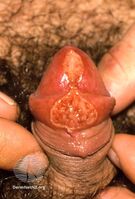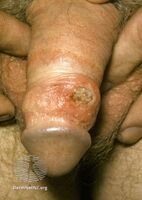Chancre

A chancre (/ˈʃæŋkər/ SHANG-kər)[1] is a painless genital ulcer most commonly formed during the primary stage of syphilis.[2] This infectious lesion forms around 21 days after the initial exposure to Treponema pallidum, the gram-negative spirochaete bacterium causing syphilis, but can range from 10 to 90 days.[2] Without treatment it may persist for two to six weeks before healing.[2] Chancres transmit syphilis through direct physical contact. These ulcers usually form on or around the anus, mouth, penis and vulva.
Chancres, as well as being painless ulcerations formed during the primary stage of syphilis, are associated with the African trypanosomiasis sleeping sickness, surrounding the area of the tsetse fly bite.
Similarities with chancroid
Similarities between the conditions chancre and chancroid:[citation needed]
- Both originate as pustules at the site of inoculation, and progress to ulcerated lesions
- Both lesions are typically 1–2 cm in diameter
- Both lesions are caused by sexually transmissible organisms
- Both lesions typically appear on the genitals of infected individuals
Differences from chancroid
Differences between the conditions chancre and chancroid:[citation needed]
- Chancre is a lesion typical of infection with the bacterium that causes syphilis, Treponema pallidum
- Chancroid is a lesion typical of infection with the bacterium Haemophilus ducreyi
- Chancres are typically painless, whereas chancroid are typically painful
- Chancres are typically single, whereas chancroid are typically multiple
- Chancres cause regional bilateral lymph node enlargement, whereas chancroid cause regional unilateral lymph node enlargement
- Chancres typically exude serum, whereas chancroid typically have a grey or yellow purulent exudate
- Chancres have a hard (indurated) base with sloping edges, whereas chancroid have a soft base with undermined edges
- Chancres heal spontaneously within three to six weeks, even in the absence of treatment
- Chancres can occur in the pharynx as well as on the genitals. Not to be confused with condylomata lata, which is seen in secondary syphilis
Etymology
The word "chancre" (French pronunciation: [ʃɑ̃kʁ]) means "little ulcer" in Old French. Related to the English "canker", they both come from the Latin cancer, meaning "crab",[3] which is a translation from the Greek word καρκίνος (karkínos), also meaning "crab".[4]
Additional images
-
Chancre
-
Chancre
-
Two chancres on the penile shaft, caused by primary syphilis. Chancres develop at the site of Treponema pallidum inoculation.
See also
References
- ↑ chancres Archived 2018-07-17 at the Wayback Machine thefreedictionary[full citation needed]
- ↑ 2.0 2.1 2.2 Ghanem, Khalil G.; Hook, Edward W. (2020). "303. Syphilis". In Goldman, Lee; Schafer, Andrew I. (eds.). Goldman-Cecil Medicine. Vol. 2 (26th ed.). Philadelphia: Elsevier. pp. 1983–1989. ISBN 978-0-323-55087-1. Archived from the original on 2023-06-30. Retrieved 2023-05-08.
- ↑ medterms.com Archived 2012-08-06 at the Wayback Machine[full citation needed]
- ↑ Ayto, John (1990). Dictionary of Word Origins. New York: Arcade Publishing, Inc. p. 94. ISBN 1-55970-214-1.
- Webarchive template wayback links
- All articles with incomplete citations
- Articles with incomplete citations from February 2017
- Articles with invalid date parameter in template
- All articles with unsourced statements
- Articles with unsourced statements from May 2021
- Bacterium-related cutaneous conditions
- Medical signs
- Syphilis


